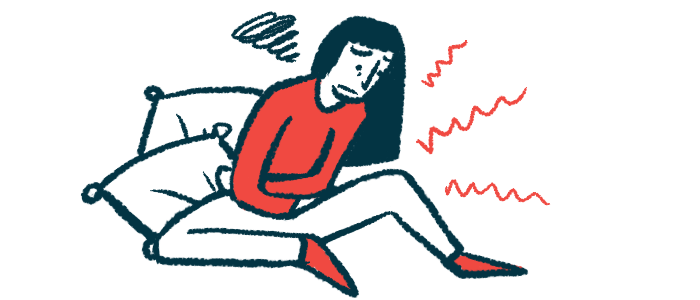Routine screening may be tool to help ID pain in young SCD patients
Nearly 1 in 3 children, teens reported persistent or chronic pain in study

Nearly 1 in 3 children and teens with sickle cell disease (SCD) reports persistent or chronic pain, according to a new study that tested how well routine screening for pain worked as a tool to help identify those pediatric patients with the greatest need for interventions.
“Pain screening fit well within the clinic workflow, and it gave patients a way to discuss their pain in new ways with their parents, caregivers, and medical providers,” Dennis Vroom, a medical student at Case Western Reserve University School of Medicine, in Cleveland, and the study’s first author, said in a press release.
According to Vroom, such screening was a useful tool for “asking not just when and how long [these children and adolescents] were having pain but how it was affecting their daily life and mental health.”
The findings were detailed in “Pain screening in youth with sickle cell disease: A quality improvement study,” which was published in the journal Pediatric Blood & Cancer. The work stemmed from a collaborative effort by researchers at University Hospitals Connor Whole Health and Rainbow Babies & Children’s Hospital, both in Cleveland, to better assess the usefulness of such assessments as a screening tool.
The researchers together are working on a “quality improvement project where pain screening procedures were embedded within an outpatient pediatric sickle cell disease (SCD) clinic.”
Onset of chronic pain ‘insidious’ for most SCD children as they grow
SCD is a genetic disease that causes red blood cells to become rigid and take on a sickle-like shape. The change in shape is caused by the presence of a faulty form of hemoglobin, which is the protein in red blood cells that carries oxygen around the body.
Sickle-shaped red blood cells tend to stick to each other, and onto the inside of blood vessels, blocking the flow of blood to body tissues and organs. This can cause many complications, including episodes of acute pain called vaso-occlusive crises (VOCs).
According to researchers, many of the challenges children and adolescents with SCD face while getting older “are related to pain as pain frequency, duration, and severity often increase as children with SCD age into adolescence.”
Amma Owusu-Ansah, MD, is the director of the Pediatric Sickle Cell Anemia Center at Rainbow Babies and treats many of these patients.
“The onset of chronic pain is insidious, and the individual may realize they have more frequent episodes of pain or that their pain never completely disappears after a vaso-occlusive pain episode like it used to,” Owusu-Ansah said.
“Without realizing [it,] they have developed chronic pain,” Owusu-Ansah added.
It is thought that integrative medicine, an approach to healthcare that includes interventions such as music and art therapy that are not traditionally part of conventional medicine, may help manage pain related to SCD.
But according to researchers, “few studies have implemented screening protocols to identify chronic pain,” and little is known about the effectiveness of such assessments as a tool in the clinics.
This led the team to test the use of routine screening for pain in the clinical setting.
“With accumulating data supporting the benefits of these modalities, appropriate screening and triage are needed to best optimize delivery of these interventions,” the researchers wrote.
PASSKEY used as screening tool for pain in this study
The study included 141 children and adolescents, ages 8 to 18, who were receiving care at the Rainbow Babies hospital. Among these patients, nearly one-quarter — 104 or 73.8% — completed the PAin Screening in SicKle cEll Youth (PASSKEY) assessment.
The screening included questions about the frequency and duration of pain, as well as how pain affected a patient’s physical and mental health. The Pediatric Pain Screening Tool (PPST) was used to calculate a patient’s risk for persistent symptoms and disability.
Data were stored in a database called REDCap. In addition to streamlining screening, the database also automatically calculated a score based on the frequency and duration of pain, as well as on the risk for persistent symptoms and disability.
Patients who reported at least 15 days of pain a month — lasting less than six months and thus labeled persistent, or continuing for six months or longer and identified as chronic — or those at medium to high risk for persistent symptoms and disability were asked about how pain interfered with their daily activities or thoughts.
Among the the youth completing PASSKEY, nearly one-third (34 patients) reported persistent or chronic pain, and almost half (48 patients; 46%) had a medium to high risk for experiencing persistent symptoms and disability.
Those who went on to answer additional questions reported a mean pain interference T-score of 53.2. The pain interference questionnaire worked as a screening tool to measure how pain has interfered with daily activities in the past seven days; a score higher than 50 indicates worse than normal levels of pain.
Children, teens with pain say art and music therapy may help
When asked about their thoughts on pain, these children and teens reported moderate pain catastrophizing, or a tendency to view pain as considerably worse than it actually is, and to feel too worried and helpless, as though there is no way to control the pain.
The respondents expressed interest in engaging in various arts and exercise therapies to help manage pain related to SCD. Specifically, 56% were interested in music therapy, 52% in art therapy, 39% in massage therapy, and 26% in yoga. In general, they preferred in-person (82%) over virtual interventions (22%).
Alongside other measures of pain, “PPST risk categories may provide a pathway for triaging pain interventions using a stepped care model,” the researchers wrote, noting that “patients expressed greatest interest in music and art therapy and preferred in-person over virtual delivery.”
What this study adds is a systematic process for us to identify patients at high risk for persistent pain symptoms and disability early so that we can intervene and equip adolescents and young adults with SCD with the skills needed to better manage their pain.
The team, including Samuel Rodgers-Melnick, one of the study’s authors, said these finding can help to better serve youth with SCD.
“What this study adds is a systematic process for us to identify patients at high risk for persistent pain symptoms and disability early so that we can intervene and equip adolescents and young adults with SCD with the skills needed to better manage their pain,” Rodgers-Melnick said.
Francoise Adan, MD, chief whole health and well-being officer at UH and director of UH Connor Whole Health, said pain screening would be a useful tool in the clinical setting.
“By embedding pain screening procedures within routine care, we are better able to serve this population,” Adan said.
Vroom, who helped to streamline the workflow for routine screening, said “this was valuable and made everyone more eager to complete the screening to better understand what the patient was experiencing.”








